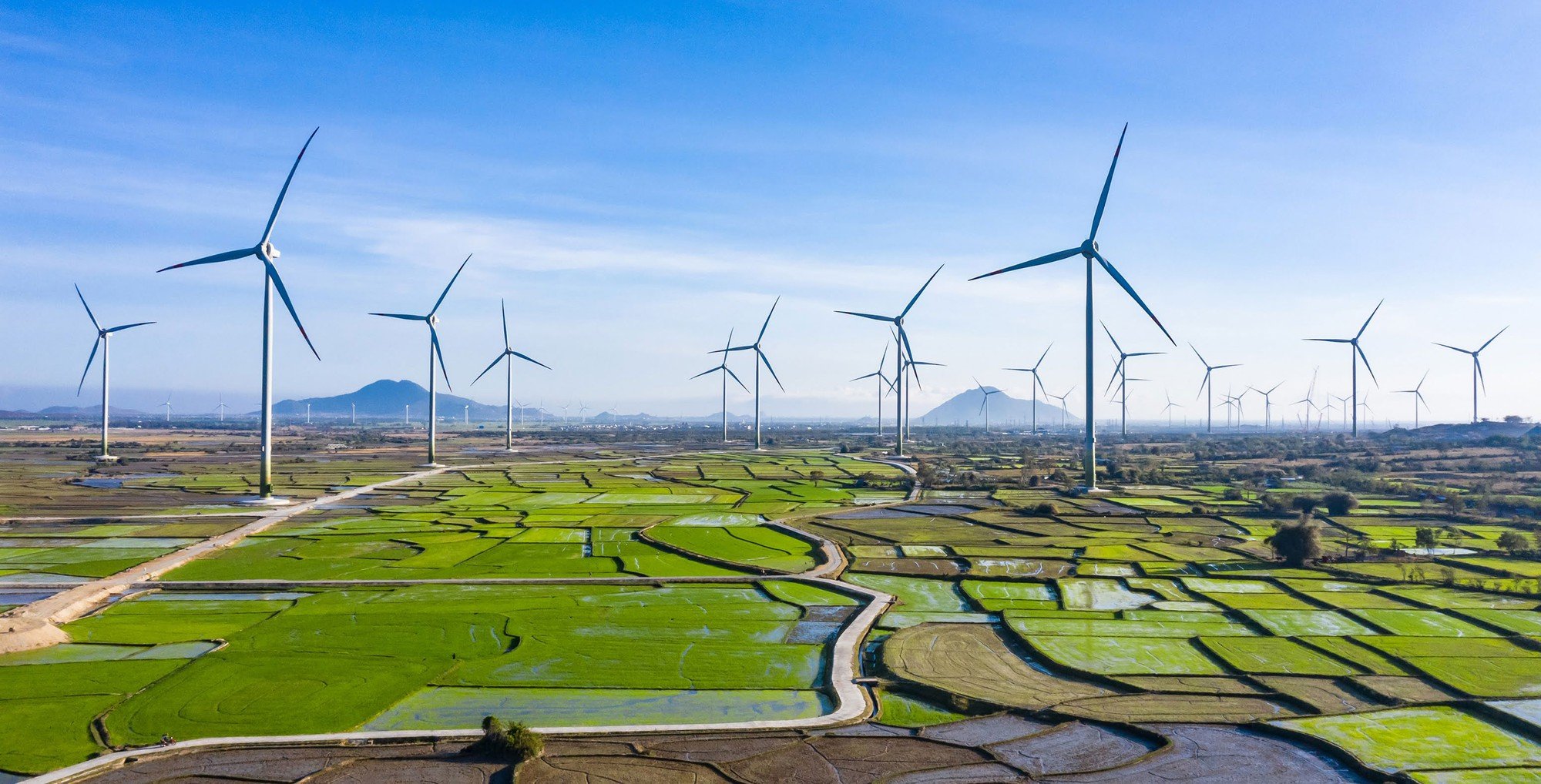Power Plan 8 towards clean energy
The national power development plan for the 2021-2030 period, with a vision to 2050 (Power Plan 8) approved by the Prime Minister emphasizes the priority of developing renewable energy and new energy.
The electricity industry is shifting energy, gradually reducing and moving towards not using fossil energy, aiming for carbon neutrality by 2050, which is the inheritance and promotion of the results of Power Plan 7 and the adjusted Power Plan 7 in developing renewable energy sources (wind power, solar power).

Power planning 8 prioritizes the development of wind and solar power sources.
In the report on the power system operation plan for 2023, Vietnam Electricity Group (EVN) noted that in 2022, the electricity output from renewable energy sources (wind, solar, biomass) reached 35.647 billion kWh (accounting for 13.2% of electricity output). Of which, the actual solar power output alone reached 26.302 billion kWh, an increase of 723 million kWh compared to 2021. In contrast, electricity produced from coal-fired thermal power in 2022 was 105.173 billion kWh, a decrease of 19.451 billion kWh compared to 2021. Just calculating the cost savings due to not having to mobilize 19.451 billion kWh of coal power (due to solar power replacement), EVN saved over 20,000 billion VND.
According to EVN's forecast, the average price of imported coal this year will reach 330 USD/ton, leading to an increase in the price of electricity from imported coal-fired thermal power plants to 3,537.21 - 4,230.4 VND/kWh (equivalent to 14.2 - 16.9 US cents/kWh). To save operating costs, electricity produced from renewable energy sources will be mobilized by EVN up to 37.238 billion kWh (an increase of 1.6 billion kWh compared to 2022); solar power alone will be 26.54 billion kWh (an increase of 238 million kWh compared to 2022). Accordingly, this year, renewable energy sources will save EVN about 70,000 billion VND.
Also according to EVN, in the period 2019 - 2022, electricity output from wind and solar power sources increased from 5.242 billion kWh to 34 billion kWh, contributing to a significant reduction in high-priced oil-fired electricity. If comparing the actual mobilized oil-fired electricity data with EVN's forecast, oil-fired electricity decreased by 2.17 billion kWh in 2019 and decreased by 4.2 billion kWh in 2020, equivalent to saving about 10,850 - 21,000 billion VND.
Not only does it actively support the supply of electricity to the North when there is a shortage of power and high load (like in May - June 2021), this renewable energy source contributes to reducing greenhouse gas emissions and other pollution emissions such as: SOx, NOx, dust, heat.
The report of the Center for Research on Energy and Clean Air (CREA) and the Institute for Energy Economics and Financial Analysis (IEEFA) also noted that the development of solar power in Vietnam in recent years has saved 1.7 billion USD (equivalent to 40,000 billion VND), due to not having to use additional fossil fuels. In particular, Vietnam has formed a renewable energy market. Enterprises have accumulated capacity and experience in investing and developing renewable energy.
Developing renewable energy ecosystem
According to Power Plan 8, Vietnam aims to strongly develop renewable energy sources for electricity production. By 2030, 50% of office buildings and 50% of houses will use self-generated and self-consumed rooftop solar power (for on-site consumption, not selling electricity to the national power system). By 2050, the proportion of renewable energy is expected to reach 67.5 - 71.5%.
In particular, in the Power Plan 8, Vietnam will develop an industrial ecosystem and renewable energy services. It is expected that by 2030, 2 inter-regional industrial and renewable energy service centers will be formed, including electricity production, transmission and consumption; renewable energy equipment manufacturing industry, construction, installation, related services, building a renewable energy industrial ecosystem in areas with great potential such as the North, South Central and South. In addition, Vietnam will develop renewable energy sources and produce new energy for export. By 2030, the scale of electricity export capacity will reach about 5,000 - 10,000 MW.
According to Dr. Ngo Tuan Kiet, Director of the Institute of Energy Technology (Vietnam Union of Science and Technology Associations), Power Plan 8 shows that Vietnam is ready to fulfill its international commitments on developing renewable energy and clean energy.
In the energy development transition, Power Plan 8 considers the formation of renewable energy centers, not only connecting to the Vietnamese grid but also aiming to serve electricity export. These are very new points in Power Plan 8 compared to previous plans. In addition, Power Plan 8 has considered the development of reserve sources, pumped storage hydropower to produce hydrogen, ammonia for green energy development. These are also very new contents to ensure national energy security.
Dr. Ha Dang Son, Director of the Center for Energy and Green Growth Research, said that the Power Plan 8, approved after 2 years of review, will create a legal corridor for the implementation of power transmission projects, helping to release capacity for renewable energy projects in the Central and Southern regions as well as 500 kV power lines, helping to balance supply and demand between the three regions of the North - Central - South.
Besides, Power Plan 8 has a roadmap to reduce coal power. After 2030, Vietnam will not build new coal-fired thermal power plants and will require the remaining plants to switch to using clean fuels such as biomass... This decision will help Vietnam fulfill its commitment to climate change, achieving net zero emissions at COP26 as well as the Political Declaration on a Just Energy Transition (JETP).
Mr. Tran Viet Ngai, Chairman of the Vietnam Energy Association, said that the Power Plan 8 aims to increase renewable energy to 67.5 - 71.5% by 2050, showing Vietnam's great determination in developing green and clean electricity sources. However, relying only on low-capacity solar and onshore wind power sources with unstable exploitation will make it difficult to achieve this goal. Meanwhile, through research and surveys, it has been shown that with the same capacity, an offshore wind power plant will produce 3 times more electricity than an onshore wind power plant.
"Vietnam has a coastline of over 3,200 km, so there will be no shortage of places for us to build offshore wind power plants, and this should be considered a huge advantage for developing renewable energy. In implementing the upcoming Power Plan 8, we should continue to research and build a legal framework and policies to attract investment in offshore wind power to contribute to achieving the renewable energy goals set out in the plan," said Mr. Ngai.
Source link










![[Video] More than 100 universities announce tuition fees for the 2025–2026 academic year](https://vphoto.vietnam.vn/thumb/1200x675/vietnam/resource/IMAGE/2025/7/18/7eacdc721552429494cf919b3a65b42e)


















































































![[Infographic] In 2025, 47 products will achieve national OCOP](https://vphoto.vietnam.vn/thumb/402x226/vietnam/resource/IMAGE/2025/7/16/5d672398b0744db3ab920e05db8e5b7d)





Comment (0)